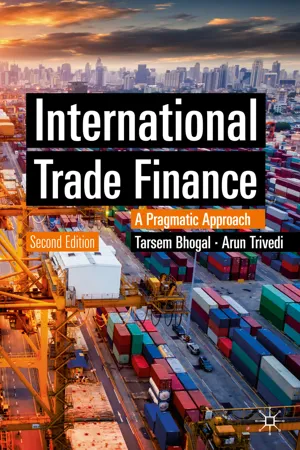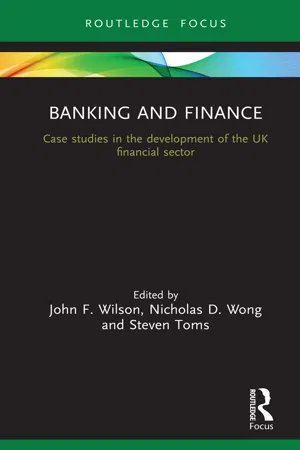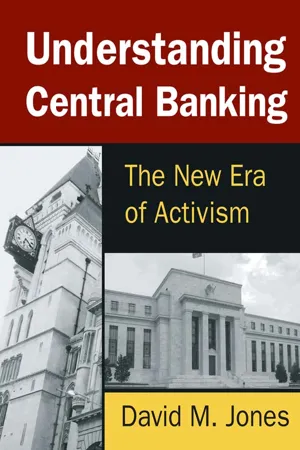Commercial Banks
Commercial banks are financial institutions that provide a range of services to individuals, businesses, and governments. They accept deposits, make loans, and offer various financial products such as savings accounts, checking accounts, and certificates of deposit. Commercial banks also play a crucial role in the economy by facilitating the flow of funds and providing essential financial services.
7 Key excerpts on "Commercial Banks"
- eBook - ePub
Contemporary Economics
An Applications Approach
- Robert Carbaugh(Author)
- 2016(Publication Date)
- Routledge(Publisher)
...This explains why banks like to advertise daily compounding rather than annual or quarterly compounding. Also, it’s not just time that adds to the future value of money—it’s also the interest rate. Obviously, a higher interest rate will earn you more money. Let’s reconsider the Native Americans’ sale of Manhattan Island to Peter Minuit. If the Native Americans had invested their $24 at 10-percent interest compounded annually at the end of 1624, they would have had about $129 quadrillion by the end of 2004. If they had invested the $24 at a slightly lower interest rate—say, 8 percent—they would have had only $121 trillion by the end of 2004. The Business Of Banking A commercial bank is a corporation that seeks to make a profit for its stockholders. How does a bank operate? To understand the business of banking more clearly, we can look at a bank’s balance sheet, a tool that is used by accountants. A Bank's Balance Sheet A balance sheet is a two-column list that shows the financial position of a bank at a specific date. It shows everything of value that the bank owns (assets), the debts that it owes (liabilities), and the amount of the owners’ investment (net worth) in the bank. The difference between a bank’s assets and liabilities is its net worth. When a bank is established, its owners must place their own funds into the bank. These funds are the bank’s initial net worth. If a bank makes profits, its net worth will rise. Conversely, the bank’s net worth will fall if it incurs losses. Table 14.4 shows the consolidated balance sheet for all Commercial Banks in the United States as of August 2015. We will use this picture of the entire banking system to get an idea of what a commercial bank does and the importance of the various assets and liabilities to an average or typical commercial bank in this country. Let us consider the assets of the commercial banking system, which we see on the left side of Table 14.4...
- eBook - ePub
The Bank Credit Analysis Handbook
A Guide for Analysts, Bankers and Investors
- Jonathan Golin, Philippe Delhaise(Authors)
- 2013(Publication Date)
- Wiley(Publisher)
...In contrast, nonfinancial firms, with a few exceptions, are lightly regulated in most jurisdictions, and governments generally take a hands-off policy toward their activities. In most contemporary market-driven economies, if an ordinary company fails, it is of no great concern. This is not so in the case of banks. Because they depend on depositor confidence for their survival, and since governments neither want to confront irate depositors, nor more critically, contend with a significant number of banks unable to function as payment and credit conduits, deposit-taking institutions are rarely left to fend for themselves and go bust without a passing thought. Even where deposit insurance exists and depositors remain pacified, the failure of a single critical financial institution may be plausibly viewed by policymakers as likely to have a detrimental impact on the health of the regional or national financial system. Moreover, the costs of repairing a banking crisis typically far outweigh the costs of taking prudent measures to prevent one. Governments therefore actively monitor, regulate, and—in light of the importance of banks to their respective economies—ultimately function as lenders of last resort through the national central bank, or an equivalent agency. Owing to the privileged position that banks commonly enjoy, their credit analysis must give due consideration to an institution’s role within the relevant financial system. Its position will affect the analyst’s assessment concerning the probability, and degree, of support that may be offered by the state—whether explicitly or more commonly implicitly—in the case the bank experiences financial distress. Making such assessments not only calls for consideration of applicable laws and regulations, but also relevant institutional structures and policies, both historic and prospective...
- eBook - ePub
International Trade Finance
A Pragmatic Approach
- Tarsem Bhogal, Arun Trivedi(Authors)
- 2019(Publication Date)
- Palgrave Macmillan(Publisher)
...© The Author(s) 2019 T. Bhogal, A. Trivedi International Trade Finance Finance and Capital Markets Series https://doi.org/10.1007/978-3-030-24540-5_2 Begin Abstract 2. Services Offered by Commercial Banks Tarsem Bhogal 1 and Arun Trivedi 1 (1) London, UK End Abstract The finance of international trade forms an important part of any major bank’s services package. Many banks have specialised departments to handle the various aspects involved, comprising experienced staff able to cope with the demands of customers with overseas business to transact. Trade Enquiries: Banks with overseas branch networks or correspondent banking relationships are able to identify potential markets for their exporting customers, and assist to an extent with the introduction to their importing customers overseas. Credit Information: By using the standard form of bank-to-bank status enquiry it is possible for banks based in the UK to obtain information on importers, for example in respect of their creditworthiness, from banks overseas. Economic and Political Reports: Many large international banks employ economists who provide reports on a number of countries, which are useful to exporters, particularly if the country concerned is politically unstable or its economy is weak. Travel Services: In addition to the usual services available to the travelling business executive, such as travellers cheques and foreign currency, the banks may also be able to provide a letter of introduction addressed to their overseas branch or correspondent. This letter introduces the customer and requests that all possible assistance is given so that local trading terms and conditions may be fully understood. Exchange Control Regulations: Many countries have restrictions on the amount of local and/or foreign currency that can be taken into and out of the country at any one time...
- eBook - ePub
- Thomas Crump(Author)
- 2011(Publication Date)
- Routledge(Publisher)
...10 The development of commercial banking Exchange banking A bank is an institution with three possible functions, which, in historical order, may be called conversion, deposit and giro. The origins of the first of these, conversion, are to be found in the profession of money-changer, which developed very soon after the separate Greek city states each began to issue their own silver coins (Bogaert, 1966, p. 136). 1 Its basis in any city was the sale and purchase of foreign coin, with payment in the local currency, and a margin between the prices paid which gave the money-changer his profit. The table, or trapedza, at which the money-changer carried on his trade provided the word which is still that for ‘bank’ in modern Greek. When, at the dawn of the Renaissance, Italian money-changers began to carry on their business in the same way, the Latin equivalent, bancum, was used and eventually became current usage for a ‘bank’ in almost every part of the world—except Greece (ibid., p. 144). As chapter 15 below will show, this form of foreign exchange was—except in the ancient world—of relatively minor importance: it did however provide the basis for depost banking, so its historical importance can hardly be underrated. The rise of deposit banking The stock in trade of the money-changer was money, the most immediately valuable, because the most liquid, of all the assets known to the local economies in which he operated. The money-changer had then, by force of circumstance, to have a safe deposit for his own stock of foreign coin, so it is not surprising that others who wished to keep their money safe entrusted it to him. The money-changer who accepted such deposits became a banker by keeping no more than a reserve of money to meet the claims of the depositors, investing the balance of the sums deposited in loans and trading ventures (Bogaert, 1966, pp...
- eBook - ePub
Banking and Finance
Case studies in the development of the UK financial sector
- John F Wilson, Nicholas Wong, Steven Toms(Authors)
- 2020(Publication Date)
- Routledge(Publisher)
...However, it has to be admitted that among banking historians, though usually not those who have written histories of banks, investigations of business structure, employment patterns, work organisation, labour relations and technological choice are notable usually for their omission. Nevertheless, these features of Commercial Banks, despite previous neglect, do have a wider significance for economists and economic historians and challenge a number of well-established historiographic prejudices. Although banks are often treated as a special case, perhaps largely because their products are intangible, if not magical, to some observers, an investigation of bank organisation and performance can shed light on some often neglected aspects of modern economic growth. Three interrelated themes are highlighted here which suggest that the development of modern Commercial Banks can reveal significant but underappreciated facets of this vitally important phenomenon. These three themes, which are discussed in the context of British commercial banking before 1939, recognise: first, the relative importance of the services in a modern economy, for which banking here stands as representative of that general class of activity; second, the functional significance of the financial sector and its relationship with other sectors of a modern economy; and, third, the consolidation of banks as large corporations which developed organisational structures adapted for the performance of banking activity in dynamic circumstances...
- eBook - ePub
- Enrico Colombatto(Author)
- 2016(Publication Date)
- Routledge(Publisher)
...And when they refer to the ‘money multiplier’, they actually mean the M1/M0 or the M2/M0 ratio. 7.6 Getting closer to the real world: central banking The second element refers to the creation of central banking. By and large, a central bank can play two roles, depending on statutes. It can operate as the banks’ bank, i.e. the institution in which Commercial Banks deposit their assets or from which they borrow money. And it can also be a government agency with privileges and law-making power (including monopoly of note issue and regulation). In truth, a monetary system that operates according to the guidelines described in the previous section does not really need a banks’ bank, except perhaps for the purpose of pooling resources and developing an interbank insurance system. For example, given a fractional reserve system (R <100 per cent), a commercial bank subject to the depositors’ unpredictable demand for cash might need to adopt a relatively high reserve ratio R 1, even when it knows it needs only R 2 on average (with R 2 < R 1). By pooling reserves, however, the shocks of unpredictable demand are absorbed by the whole banking system, so that each bank needs to keep in store only R 2 at all times. Similarly, banks might agree to create a reserve fund that would guarantee depositors against a single bank's failure, possibly monitor at least part of the banks in activity, and inform the depositors accordingly. Under these circumstances, the name on the building hosting the common vault, the common insurer, and the supervisors might well be ‘bankers’ bank’ or ‘central bank’. However, the role of the central banker might change drastically in a scenario in which one believes that monetary and credit matters should not be left to the unfettered interaction of individuals – depositors, bank managers, borrowers; that an appropriate regulatory corset should be enforced; and that a dedicated agency should be in charge...
- eBook - ePub
Understanding Central Banking
The New Era of Activism
- David Jones(Author)
- 2014(Publication Date)
- Routledge(Publisher)
...1 History and Purpose of Central Banking Reduced to its essence, central banking is critical in maintaining an orderly modern economy, but it has proved to be more art than science. No matter how sophisticated the analysis of the impact of monetary policy on the financial markets and how they, in turn, influence spending, output, employment, and inflation, central banking comes down to a process of trial and error, observation and adjustment. To be sure, only central banks have the special power to increase aggregate liquidity in their respective financial systems. Moreover, reasonably independent central banks like our Federal Reserve (the Fed) can react more promptly to financial crises than slow-moving legislatures or other government agencies on the fiscal side. Nevertheless, when fighting financial crises, it has been the Bernanke Fed’s artful innovation, timing, and the unexpectedly large scale of its actions that have saved the day, steering us away from a second Great Depression while rebuilding shattered market confidence. In short, it was Fed chairman Ben Bernanke’s willingness “to do whatever it takes” that kept the U.S. economy afloat, as emphasized by David Wessel in his excellent book, In FED We Trust: Ben Bernanke’s War on The Great Panic (2009). L ENDER OF L AST R ESORT Traditionally, central banks have been viewed as lenders of last resort. The central bank is the institution that your commercial bank turns to in a financial crisis when it is under assault by depositors and short-term bank debt holders demanding immediate cash in return for these bank liabilities. The Bank of England—founded in 1694 as the nation’s official bank, early debt manager, and clearinghouse—has successfully refined its role as a lender of last resort over the years and thus could be considered the bloodline ancestor of modern central banking. The Bank of England was nationalized in 1946, and subsequently became an independent public organization in 1997...






